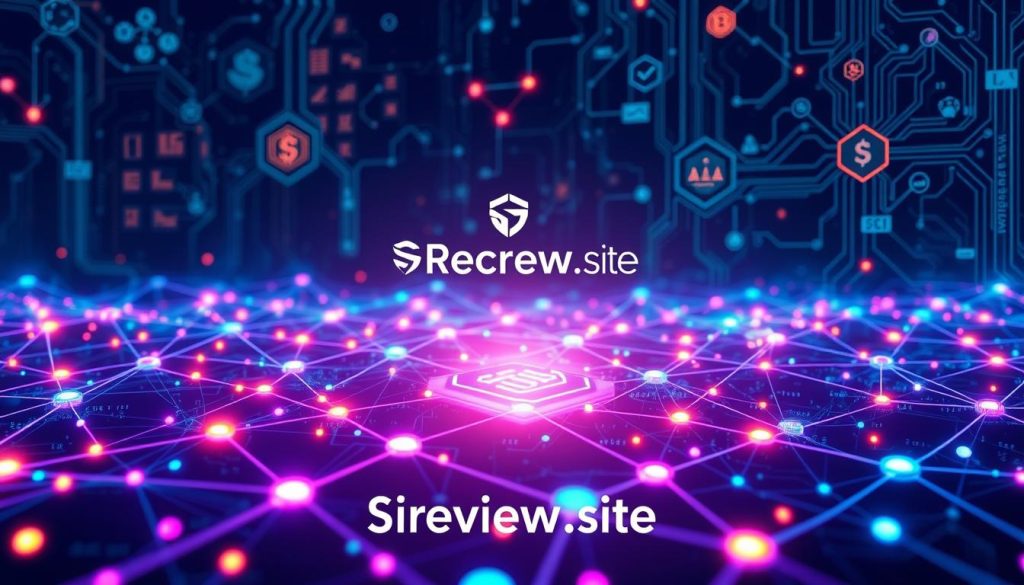A new movement is changing the finance world fast – Decentralized Finance (DeFi). It uses blockchain technology to make finance more open, accessible, and clear. This change helps both individuals and businesses.
Smart contracts are key to DeFi. They make financial deals happen automatically, without middlemen. This use of blockchain is shaking things up. It gives users more control, saves money, and includes more people in finance.
Key Takeaways
- Decentralized Finance (DeFi) is a revolutionary movement that leverages blockchain technology to create a more open, accessible, and transparent financial ecosystem.
- DeFi platforms utilize smart contracts to automate financial transactions, reducing the need for traditional intermediaries.
- The decentralized nature of DeFi offers users greater control, reduced costs, and improved financial inclusion.
- DeFi is disrupting traditional finance by providing innovative solutions that challenge the status quo.
- Blockchain technology is the foundational driver behind the growth and development of the DeFi ecosystem.
Understanding the Fundamentals of DeFi and Blockchain Technology
Decentralized Finance (DeFi) is changing the way we think about money. It uses blockchain technology to make new ways to lend, trade, and use money. This technology lets people connect directly, without banks.
The Core Principles of Decentralized Finance
DeFi is all about being open, fair, and easy for everyone. It wants to make finance more democratic. This means no more middlemen, so people can deal with each other directly.
How Blockchain Enables DeFi Innovation
Blockchain is the key to DeFi. It makes sure everything is safe and clear. This lets DeFi apps handle money without needing a boss.
Key Components of DeFi Infrastructure
- Decentralized Exchanges (DEXs): These platforms let you swap digital money easily, without a middleman.
- Peer-to-Peer Lending: You can lend and borrow money directly, using smart contracts on blockchain.
- Automated Market Makers (AMMs): AMMs help with trading by setting prices automatically, not like old-fashioned markets.
Knowing how DeFi works and what blockchain does helps us see its big impact. It’s changing the financial world for the better.
“DeFi is not just a technology; it’s a movement that is reshaping the financial landscape, empowering individuals and challenging the status quo.”

Smart Contracts: The Building Blocks of DeFi Applications
In the world of decentralized finance (DeFi), smart contracts are key. They are the building blocks for many new financial apps. These digital agreements, stored on the blockchain, change how we do financial transactions. They bring transparency, efficiency, and trust to the table.
Smart contracts are at the heart of DeFi. They make complex financial deals happen without middlemen. Thanks to blockchain, these contracts ensure deals are done right and safely. This makes DeFi apps reliable and trustworthy.
Smart contracts have made a big difference in automated market makers (AMMs). AMMs are platforms that let people trade digital assets without a middleman. They use smart contracts to keep trading going, making it easy for users to swap tokens.
Also, smart contracts are helping the non-fungible token (NFT) world grow. They help create unique digital assets. This lets artists and creators sell their work in new ways, with smart contracts handling the details.
As DeFi keeps growing, smart contracts will be even more important. They make finance better by automating tasks, being clear, and encouraging new ideas. Smart contracts are the foundation of the DeFi revolution.

Decentralized Exchanges (DEX): Transforming Traditional Trading
Decentralized exchanges (DEXs) are changing the finance world fast. They offer a new way to trade, different from old exchanges. Users can manage their trades and assets on their own, without needing middlemen.
Popular DEX Platforms and Their Features
Top DEXs include Uniswap, Sushiswap, and Curve Finance. They let users swap tokens easily and offer chances to earn more. Each platform has its own special features, so users can pick the best one for them.
Benefits of Automated Market Makers
DEXs rely on automated market makers (AMMs). These use pools of money to make trades smooth. AMMs don’t need old-fashioned order books, making trades clear and quick. They set prices with math, keeping trades fair and preventing price tricks.
Trading Strategies in DEX Environments
DEXs open up new ways for smart investors to trade. They can try arbitrage, earn passive income, or help with liquidity. These chances, along with DEXs’ openness, draw more people to DeFi.
DEXs have changed the way we trade, giving power to users and sparking new ideas in finance. As DeFi grows, DEXs will keep playing a big role in shaping the future of trading.
Yield Farming and Liquidity Pools: Maximizing Returns
In the world of DeFi, yield farming and liquidity pools are key for making more money. Yield farming means giving liquidity to DeFi projects for rewards, often in their own tokens.
Liquidity pools are the heart of DEXs, where people put in digital assets for trading. By adding to these pools, users get a cut of the trading fees.
Yield farming and liquidity pools offer great returns. Users can earn passive income by just locking assets in smart contracts. This is great for those wanting steady income in a shaky market.
But, there are risks like impermanent loss and smart contract bugs. It’s vital to research and understand these risks before diving in.
Stablecoins and Yield Farming
Stablecoins like USDC and DAI are key in yield farming. They keep a stable value, making them safe for earning yields without worrying about price swings.
| Yield Farming Platform | Annual Percentage Yield (APY) | Supported Stablecoins |
|---|---|---|
| Compound | 2.88% | USDC, DAI |
| Aave | 3.12% | USDC, DAI, USDT |
| Curve Finance | 4.05% | USDC, DAI, USDT |
Using stablecoins in yield farming can lead to steady returns. It helps investors avoid the ups and downs of other cryptocurrencies.
“Yield farming and liquidity pools are changing how we earn in the digital world. These new ways offer chances for investors to grow their money and join the DeFi movement.”
The Role of Stablecoins in Decentralized Finance (DeFi): Revolutionizing the Financial Industry
Stablecoins are key in the DeFi world, linking traditional finance to blockchain innovation. They keep a stable value, often tied to assets like the US dollar. This makes them a reliable choice for trading and helps reduce the ups and downs of crypto prices.
Types of Stablecoins in DeFi
The DeFi space has many stablecoins, each with its own special traits. You have fiat-collateralized ones like Tether (USDT) and USD Coin (USDC). Then there are algorithmic stablecoins like DAI. This variety meets the needs of different users and projects.
Stablecoin Use Cases and Applications
Stablecoins have changed the DeFi scene, making it more stable for various financial tasks. They make it easy to send money across borders, support lending and borrowing, and are used in decentralized exchanges (DEXs). They also protect investors’ digital assets when markets are shaky.
Risk Management with Stablecoins
Stablecoins are vital for managing risks in DeFi. They offer a stable place to hold value, reducing crypto price swings. This lets users trust DeFi more and feel secure. Stablecoins also make DeFi systems stronger and more stable overall.
FAQ
What is Decentralized Finance (DeFi)?
Decentralized Finance, or DeFi, is a new way to handle money using blockchain and smart contracts. It makes finance more open and fair. DeFi offers services like lending, borrowing, and trading without banks.
How does DeFi leverage blockchain technology?
DeFi uses blockchain for safe, direct money moves. Smart contracts do the work, cutting out middlemen. This makes finance clear and fair.
What are the key components of DeFi infrastructure?
DeFi’s core parts are decentralized exchanges, lending platforms, and liquidity pools. These help make finance safe and open, without banks.
How do smart contracts enable DeFi applications?
Smart contracts are DeFi’s foundation. They handle money tasks, follow rules, and skip the middlemen. This lets DeFi create new financial tools.
What are the benefits of using decentralized exchanges (DEXs)?
DEXs are better because they’re easy to use, save money, and are safe. They let users trade directly, without needing banks.
What is yield farming in DeFi, and how does it work?
Yield farming is a way to earn crypto tokens by helping DeFi projects. Users add assets to pools and get rewards from trading fees.
What is the role of stablecoins in the DeFi ecosystem?
Stablecoins are key in DeFi for stable money. They help with lending, borrowing, and trading by keeping prices steady. They also help manage risks in DeFi.
Read Also: Climate Change Impacts on Home Insurance Policies





1 thought on “Revolutionizing Decentralized Finance (DeFi) in Financial industry”